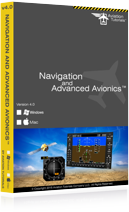PRO PILOT SOFTWARE > NAVIGATION AND ADVANCED AVIONICS

37 interactive training modules in 5 hours teach traditional VOR navigation through advanced GPS and FMS advanced avionics.
What kind of pilot are you? An advanced avionics type? A traditional navigation type?
The truth is that you've got to be both. You've got to have a solid foundation of using advanced avionics. And, you have to know how to do it old-school-style. With professional-grade knowledge of both, you'll be at your best when you need it most.
This interactive course starts with essential VOR navigation. You'll learn all the traditional VOR methods, which are current and completely applicable to today's flying. From there, advance to use of an HSI and bearing pointers. Whether you're using a mechanical HSI instrument or an electronic HSI, you'll learn how to use it like a pro. Next, GPS is introduced, explaining how it works, how it is used, and the incredible benefits for your flying. And finally, it's all tied together by teaching the essentials of advanced avionics. You'll learn what an FMS is and how its used, how to program a course, and how to make changes in flight. You'll gain a true understanding of the most important features of advanced avionics.
But, there's a lot more to know than mere button-pushing. You can't just "jump in and go." You've got to know the pitfalls and how to manage them. This training gives you the deep understanding and procedural background that are drilled into professional flight crews that use the same equipment. Whether you're using a small panel-mounted unit or a top-of-the-line multi-function display system, the topics in this training will give you a foundation that you can't learn anywhere else.
Qualify for FAA WINGS credit!
By completing all the content and taking the Final Exam, you can qualify to obtain credit for the FAA WINGS program. The WINGS program is a continuing education program for pilots, sponsored by the FAA. You'll not only learn to be a safer pilot on the airport surface—you'll also be able to prove your commitment to flight safety with your WINGS account. (Aviation Tutorials is a WINGS Training Provider.)



#1: Introduction—The overall purpose of this training is to bridge the gap between traditional navigation and advanced avionics. Both areas of knowledge are essential for today's pilot. The problem is that too many pilots are not sufficiently trained in the general concepts of advanced avionics. You can't rely on "switchology" to use advanced avionics—there are many pitfalls and ramifications that the pilot needs to be aware of. To explain this factor and to describe the use of this training, the Introduction contains these sections:
• Read This Section First
37 training modules in 5 hours of training teach traditional VOR navigation through advanced GPS and FMS advanced avionics.
